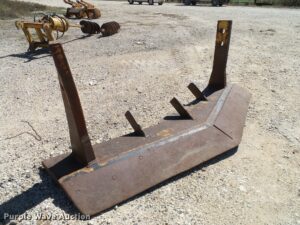Description
A rootplow is a heavy-duty, V-shaped, horizontal blade, 10- to 16-feet wide pulled by a large crawler tractor at a depth of 12 to 14 inches to sever tree roots. Tractor horsepower required to pull the integral mounted plows varies from 170 to 400. Fins are attached to the top of the blade to dislodge roots and stumps and move them near the soil surface. Commercial rootplowing averages about 2 acres/hour.
Application
The rootplow severs roots to prevent sprouting of most brush species, although it is not effective on those with shallow root systems. Plant mortality is usually 85 to 99%, but care must be taken to determine where and how it should be used. Chaining or raking following rootplowing helps to smooth the soil surface and remove sprouting species or stumps. Rootplows have been used since the 1940s to clear dense stands of mesquite and other hard-to-kill brush species in preparation for seeding to grass or crops. Sculpting dense brush infested areas by selective plowing and seeding with plants favorable for wildlife habitat, grazing animals, and watershed management could enhance the multiple-use value of depleted rangeland with fertile soils. Rocky soils prevent plowing and gravelly soils cause excessive blade wear.
References / Additional Information
Wiedemann, H.T. 2007. Sculpting brush mechanically: Current state of the art. Rangelands. 29(5): 10-17.


